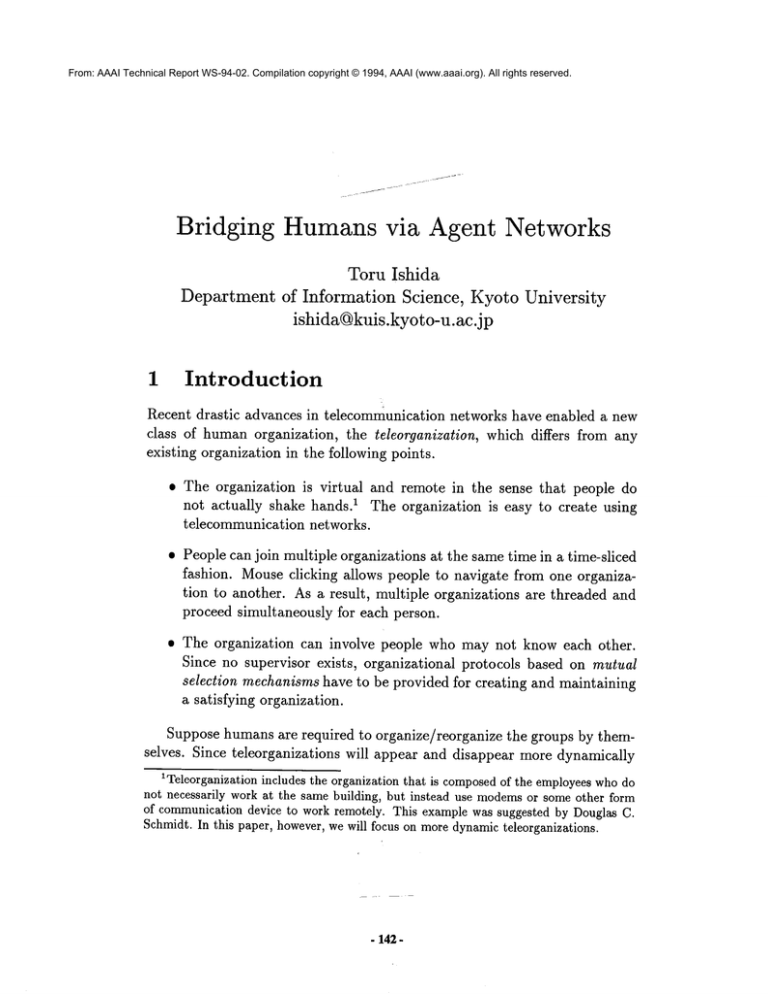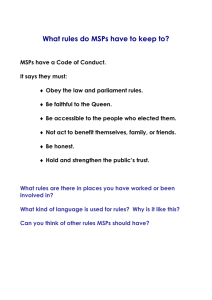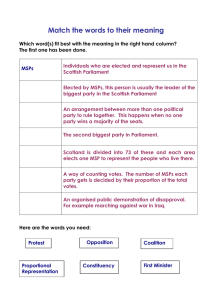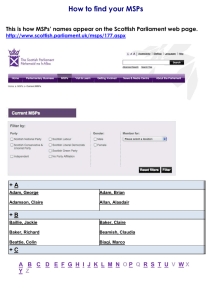
From: AAAI Technical Report WS-94-02. Compilation copyright © 1994, AAAI (www.aaai.org). All rights reserved.
Bridging
Humans via Agent Networks
Toru Ishida
Departmentof Information Science, Kyoto University
ishida@kuis.kyoto-u.ac.jp
1
Introduction
Recent drastic advances in telecommunication networks have enabled a new
class of human organization,
the teleorganization,
which differs from any
existing organization in the following points.
The organization is virtual and remote in the sense that people do
not actually shake hands3 The organization is easy to create using
telecommunication networks.
People can join multiple organizations at the same time in a time-sliced
fashion. Mouse clicking allows people to navigate from one organization to another. As a result, multiple organizations are threaded and
proceed simultaneously for each person.
The organization
can involve people who may not know each other.
Since no supervisor exists, organizational
protocols based on mutual
selection mechanisms have to be provided for creating and maintaining
a satisfying organization.
Suppose humans are required
selves. Since teleorganizations
to organize/reorganize
the groups by themwill appear and disappear more dynamically
1Teleorganization includes the organization that is composedof the employeeswhodo
not necessarily work at the same building, but instead use modemsor someother form
of communicationdevice to work remotely. This example was suggested by Douglas C.
Schmidt. In this paper, however, wewill focus on moredynamicteleorganizations.
- 142-
"
T~elecommuni{ cation
Human ~ Network
Interface
Q~
T~elMcommuni~
~ "4"11~
cation
Personal
Social ~k Network
Interface
Interface
~_
(a)
(b)
Figure 1: Personal and Social Interfaces
in Agent Networks
than conventional organizations, the overhead incurred to establish and maintain the organizations is excessive. To enjoy the recent advances in telecommunications, we need an agent network to help people organize themselves
at runtime.
This paper proposes an architecture of agent networks, where each agent
learns the preferences (or the utility
function) of the owner and acts
behalf of the owner in maintaining his/her organizations. This architecture
is especially useful when the organizing/reorganizing decisions are not critical
(suboptimal decisions permitted), but manually laborious.
Let us consider the situation in which an agent network is supporting
a human organization.
The conventional human interface,
represented in
Figure l(a), is now divided into two parts, personal and social interfaces as
described in Figure l(b). For the personal interface,
each agent adapts
each person, learns his/her preferences, and behaves as a personal assistant.
Several research results have been published along this direction [Maes et al.,
1993]. On the other hand, however, the social interface has not been discussed
before. This interface should provide protocols for bridging humans.
The rest of the paper investigates the functionalities of the social interface
in two cases: one is teleconferencin9 and the other is tele-education.
Both
cases assume the existence of B-ISDN, and will be soon extended to a more
dynamic domain, such as business meeting scheduling using PHS (Personal
Handy Phone) networks with PDA (Personal Digital Assistant)
terminals.
The mechanism of mutual selection protocols (MSPs) for organizing humans
- 143-
will be discussed based on an analysis of their dynamicproperties.
2
Network
Revolution
Telecommunicationnetworks are advancing in two directions: broadband and
personal. Optical fiber technologies will realize the so-called information
highway or B-ISDN, and wireless technologies will enable humans to communicate at anytime and anywhere.
B-ISDN
Figure 2 illustrates
the broadband network that will soon appear in the
2. The
Kansai area. The networking project is being conducted by BBCC
network consists of several ATM(Asynchronous Transfer Mode) switching
nodes, which allow 150Mbpsend-to-end
communication. The network cont .
nects four national universities including Kyoto, Osaka, Nara, and Kobe, all
of which are located in the Kansai area. Morethan 100 companies are supporting BBCCactivities. The wide variety of projects are currently being
undertaken include electronic library and telepathology.
PHS
PHS(Personal Handy System) is a wireless phone network currently being
developed in Japan. PHSis expected to start operation at the beginning
of 1995. Unlike conventional handy phones, PHSprovides digital communication at 32Kbps, roughly 10 times faster than conventional analog handy
phones. Furthermore, by using several channels at once (64Kbps with two
channels, etc.), higher speed commuhicationcan be realized.
In the near future, a voice and vision interface will be realized for PDA
terminals, whose computational power will be as large as today’s workstations. PHSand PDAwill significantly affect the interface between humans
and networks, and influence the teleorganizations created in B-ISDN.
2BBCC(Association
dertaking the various
of Broadband-ISDN Business Chance ~ Culture
activities
by implementing B-ISDN technologies
- 144-
Creation) is un[BBCC, 1993].
Figure 2: The BBCCNetwork
3
Teleorganization
Teleorganizations can be simulated on workstations connected by local area
networks, such as Ethernet or FDDI. Whenusing wide area networks, however, we think that the openness of the networks will force us to face new
organizational issues. The following two scenarios describe such situations.
CASEI: Teleconferencing
Twodifferent types of teleconferences are currently available as follows.
¯ One extreme is the E-mail conference, wherein people sit down in
front of their own workstatior/s’and discuss the same topic by sending/receiving a series of E-mail messages. The participants of the conference are never synchronized: no schedule is required to connect the
humans. Usually, for each person, multiple conferences (20 to 30 for
busy people) proceed simultaneously. The conferences are slashed into
units of 5 or 10 minutes, and accessed in a time-sliced fashion.
- 14s-
Conference
Type
E-mail Conference
Workstation Video
Conference
Video Room
Conference
Environment
Workstation
Workstation
Conference Room
Parallelism
Multiple Threads
(Parallel)
Multiple Threads
~.(Parallel)
Single Thread
(Sequential)
Synchronization
Asynchronous
Partially Synchronous
Totally Synchronous
Scheduling
No Scheduling
Online Scheduling
Offline Scheduling
Figure 3: Three Organizations in Teleconferencing
Thus, E-mail conferences have multiple threads, and are asynchronously
operated with no scheduling.
The other extreme is the videot~room conference, where people must
travel a local site that contains the required video equipment. For a
typical example, people in Tokyo use a conference room located in the
Tokyo area, and people in Kyoto use a room in Kyoto. The video room
conference saves people from moving between Tokyo and Kyoto, but
still requires them to gather at particular places. Since the conference
room is distributed amongdifferent locations, the video room conference requires more careful scheduling than conventional conferences.
The conference
is usually completed in several hours to at most several days. Since all participants
share the same time, the conference
occupies their time completely from the beginning to the end.
Thus, video room conferences have a single thread, and the participants
are totally
synchronized.
Offline scheduling is usually performed, in
advance.
Suppose the situation allow people to communicatewith sitting at their
workstations. Since B-ISDNis available, people can send voice and video. If
- 146-
(DAgent
(D
Q Agent
(a) GroupSelection Problem
(b) MemberSelection Problem
Figure 4: Organizational Problems in Tele-Education
their schedules match, more than two people can have a conference by interacting betweentheir displays. Wecall this the workstation video conference.
The workstation video conference lies somewherebetween the E-mail
and the video room conferences. The participants may not be fully
synchronized because not all of them have to meet at once. Obviously,
however, at least two participants have to be synchronized. Therefore,
the workstation video conference can have multiple threads as in the
E-mail conference, and participants are partially synchronized.
Unlike the video room conference, because of the dynamic property of
the workstation conference, online scheduling is appropriate. A mutual
selection mechanismis thus required to reflect humans’ preferences,
which dynamically change with the progress of the conference.
Figure 3 summarizesthe above scenario. The E-mail conference can easily
be combined with the workstation Video conference, because both can be
realized in the same workstation environment.
’147-
,i-tf~
CASE2: Tele-Education
B-ISDNwill enable people to learn various topics in collaboration with other
people. Wecall the learning process in telecommunication networks teleeducation. A typical example is learning a foreign language through conversation. Instructors and students hold classes on their workstation displays,
enjoying free conversation anytime their schedules match. Wethink that
forming groups in tele-education involves the following new organizational
issues.
1. Groupselection problem:
The first problem is howto select a particular group to join. Suppose
various class groups have already been established. Since the groups
are formed dynamically, it is not obvious which group is appropriate
for the new comer. Figure 4(a) represents this problem.
2. Memberselection problem:
The second problemis howto select a student whotries to join a group.
Suppose several people have already organized a group and started a
class. The signal tells them that someonewants to join their group.
Should the people accept this request? Moreover, should they stop the
class and start assessing the new comer? Figure 4(b) illustrates this
problem.
Wecan imagine that the people do not wants to spend too much time
an organizational matters. Their purpose is leaning, not organizing a learning group. Furthermore, since teleorganizations are dynamic, reorganization
requests will arrive continuously. Again, a mutual selection mechanismis
required to automatically select appropriate members. While permitting dynamic reorganization, the mechanismis also expected to maintain the quality
of the organization.
If people could establish agents that represented their preferences, the
agents could negotiate amongst themselves to resolve the member/groupselection problems: the learning group is automatically maintained, while the
membersof the group can change dynamically.
- 148-
4
Mutual Selection
Protocols
(MSPs)
Why MSPs
Let us first investigate the applicability of humanand computer communication protocols to the social interface protocols.
Humanprotocols have been analyzed and modeled by using finite state
automata. However, it appears that humanprotocols are too informal
and unsuited for accepting computational support. Various attempts
have been made, but most faii,~ because the real protocol is far more
flexible than that represented lJy finite state automata.
Computer protocols, on the other hand, are too formal, and are not
well accepted by humans. Assumethat we try to apply the two phase
locking (2PL) protocol to organize humans. The 2PL protocol employs
the two-phase rule, a transaction locks all accessing data items before
unlocking any one of them, to guarantee the serializability of transactions. Thoughthe application of the 2PL to conference scheduling can
guarantee the serializability
of threaded conferences, humanscannot
accept being locked by other people.
Both formal and informal protoco!s are not appropriate to agent networks.
Therefore, we need semi-formal pro~odols, called mutual selection protocols
(MSPs), which are characterized as follows.
¯ Each agent makes decisions based on the owner’s preferences.
¯ Organizational decisions are madethrough the mutual selection mechanism of agent networks.
Organizations have been an important research issue in the area of distributed artificial intelligence [Fox, 1981; Gasser et al., 1988; Ishida et al.,
1992; Klein, 1991]. Mutual selection protocols have been studied, including the Contract Net Protocol [Smith, 1980; Davis et al., 1983], Multi-Stage
Negotiation Protocol [Conry et al., ,1991] and Unified Negotiation Protocol
[Zlotkin et al., 1991]. Theseprotocols :have been evaluated statically [Zlotkin
et al., 1991] or for specific domains[Maloneet al., 1988; Sandholm,1993].
.149-
i00
90
8O
70
i1J
g so
-,.-I
~ 3o
20
10
0
1
0.i
i0
Mean-Arrival-Time
I
-41--Manager
-4~--Contractor
Figure 5: DynamicProperties of the Contract Net Protocol
The dynamic properties of MSPshaVenot been studied in detail. However,
their dynamic properties should be clearly explained, so that humans can
confidently leave organizational tasks to the agent networks.
Dynamic Properties
of MSPs
Let us take the Contract Net Protocol as an example. This protocol has
been applied to the system called Enterprise [Maloneet al., 1988], which performs task scheduling in distributed computing environments. TRACONET
[Sandholm, 1993] allows different vehicle companiesto negotiate to complete
their tasks. However,there is not yet enough information as to whether people can accept the Contract Net Protocol in different applications, such as
scheduling workstation video conferen,¢6s.
- 150-
We have analyzed the Contract Net Protocol by utilizing queuing models.
Figure 5 shows a part of the results obtained from our analysis. The x-axis
represents the mean arrival time of tasks to the agent network, and the y-axis
represents the utility rate of managers and contractors. This figure clearly
shows that (1) contractors’ utility rate increases with load, and (2) managers’
utility rate increases as load decreases. Wealso observed the following. (For
detailed results, see [Gu et al., 1994].)
¯ As the number of managers and contractors increases, the contractors’
average utility rate increases. Wecall this the large numbers effect of
the Contract Net Protocol. As the number of managers and contractors
increases, however, the managers’ average utility rate does not increase,
because the average number of bids for each manager does not increase.
¯ As agents become homogeneous (that means all agents share the same
preferences),
the community becomes unfair and thus the average utility rate decreases while its variance increases. Wecall this the homogeneous effect of the Contract Net Protocol.
The above analysis is informative when applying the Contract Net Protocol to human organization design. The results suggest that if the community
is homogeneous, the Contract Net Protocol may not be accepted by the members of the community. As in the above discussion, the dynamic properties
of MSPs must be analyzed in detail so that humans can accept/reject
the
protocols in various domains.
5
Conclusion
We addressed the new class of human organizations called the teleorganization, which is enabled by recent telecommunication technologies. Two example domains were given and discussed: teleconferencing
and tele-education.
Due to the dynamic nature of teleorganizations,
mutual selection protocols (MSPs) are required to organize/reorganize
humans via agent networks.
MSPs should reflect humans’ preferences,
and have clear computational dynamics. As the first step towards the theory of MSPs, we analyzed the
Contract Net Protocol by utilizing queuing models, and determined the properties of its mutual selection mechanism.
- 151-
Manyresearch issues remain. Someof them are (1) to provide a lineup
of MSPs, (2) to analyze the dynamics of these protocols, (3) to implement
applications of these protocols using B-ISDNand PHS, and (4) to evaluate
the impact of teleorganizations on humansocieties.
Acknowledgment
The author wishes to thank Cheng Gu for his efforts on evaluating the Contract Net Protocol, Toyoaki Nishida of Nara Institute of Science and Technology and Hiroshi Matsumotoof BBCCproject for their support to this work,
and Les Gasser, Tatsuya Suda, and Kazuhiro Kuwabara for their helpful
discussions.
References
[BBCC,1993] Toward Creation of new Cultural Infrastructure
Opportunities, BBCC,1993.
and Business
[Conry, 1991] S. E. Conry, K. Kuwabara, V. R. Lesser, and R. A. Meyer,
"Multistage Negotiation for Distributed Constraint Satisfaction," IEEE
Transactions on Systems, Man, and Cybernetics, Vol. 21, No. 6, pp. 14621477, 1991.
~’~’
[Davis et al., 1983] R. Davis and R. G. Smith, "Negotiation as a Metaphor
for Distributed ProblemSolving," Artificial Intelligence, Vol. 20, No. 1,
pp. 63-109, 1983.
[Fox, 1981] M. S. Fox, "An Organizational View of Distributed Systems,"
IEEE Transactions on Systems, Man, and Cybernetics, Vol. 11, No. 1,
pp. 70-80, 1981.
[Gasser et al., 1988] L. Gasser and N. Rouquette, "Representing and Using
Organizational Knowledgein Distributed AI Systems," Distributed Artificial Intelligence Workshop,1988.
- 152-
[Gu et al., 1994] C. Guand T. Ishida, "An Analysis of the Contract Net Protocol Based on Queuing Models," JSAI Annual Conference on Artificial
Intelligence, 1994.
[Ishida et al., 1992] T. Ishida, L. Gasser and M. Yokoo,"Organization SelfDesign of Distributed Production Systems," IEEE Transactions on Knowledge and Data Engineering, Vol. 4, No. 2, pp. 123-134, 1992.
[Klein, 1991] M. Klein, "Supporting Conflict Resolution in Cooperative Design Systems," IEEE Transactions on Systems, Man, and Cybernetics,
Vol. 21, No. 6, pp. 1379-1390, 1991.
[Maes et al., 1993] P. Maes and R. Kozierok, "Learning Interface Agents,"
AAAI-93, 1993.
[Malone et al., 1988] T. W. Malone, R. E. Fikes, K. R. Grant and M. T.
Howard, "Enterprise: A Market-like Task Scheduler for Distributed Computing Environments," In B. A. HubermanEditor, The Ecology of Computation, North-Holland, pp.177-205, 1988.
[Sandholm, 1993] T. Sandholm, "An Implementation of the Contract Net
Protocol Based on Marginal Cost Calculations," AAAI-93, pp. 256-262,
1993.
[Smith, 1980] R. G. Smith, "The Contract Net Protocol: High-Level Communication and Control in a Distributed Problem Solver," IEEE Transactions on Computers, Vol. 29, No. 12, pp. 1104-1113, 1980.
[Zlotkin et al., 1991] G. Zlotkin and J. S. Rosenschein, "Cooperation and
Conflict Resolution via Negotiation AmongAutonomousAgents in Noncooperative Domains," IEEE Transactions on Systems, Man, and Cybernetics, Vol. 21, No. 6, pp. 1317-1324, 1991.





